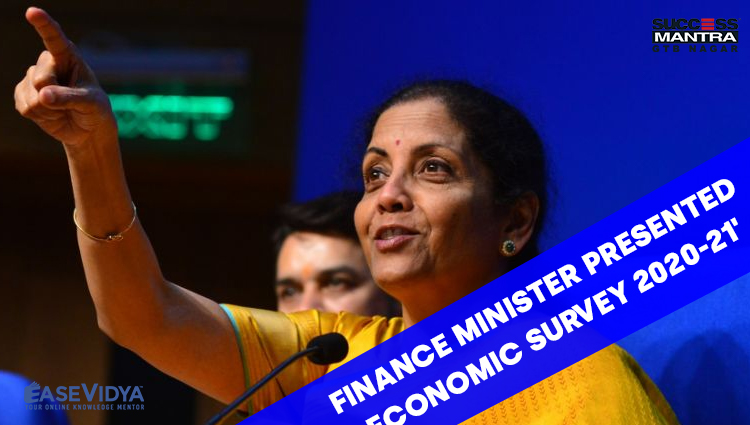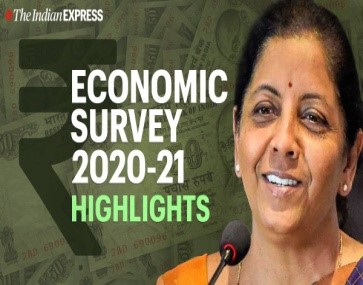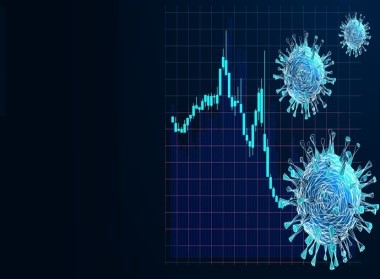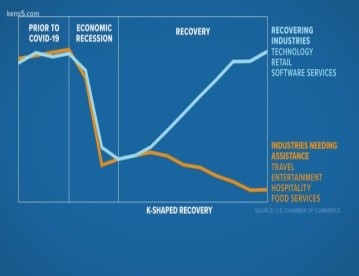
FINANCE MINISTER PRESENTED ECONOMIC SURVEY 2020 2021
FINANCE MINISTER PRESENTED ECONOMIC SURVEY 2020-21

Recently, the Union Minister of Finance presented the Economic Survey that details the state of the economy ahead of the government's budget for the fiscal year beginning 1st April, 2021. The Economic Survey of India is an annual document released by the Ministry of Finance, Government of India. It contains the most authoritative and updated source of data on India’s economy. It is a report that the government presents on the state of the economy in the past one year, the key challenges it anticipates, and their possible solutions.
The Economic Survey document is prepared by the Economics Division of the Department of Economic Affairs (DEA) under the guidance of the Chief Economic Advisor. It is usually presented a day before the Union Budget is presented in the Parliament. The first Economic Survey in India was presented in the year 1950-51. Up to 1964, it was presented along with the Union Budget. From 1964 onwards, it has been delinked from the Budget.
INDIAN ECONOMY AND COVID-19 PANDEMIC

- Strategy to face the pandemic: Human lives lost cannot be brought back. Gross Domestic Product (GDP) growth will recover from the temporary shock caused by the Covid-19 pandemic. India’s policy response also derived from extensive research on epidemiology, especially that looked at Spanish Flu of 1918. One of the key insights was that pandemic spreads faster in higher and denser population and intensity of lockdown matters most at the beginning of the pandemic.
- Four Pillar Strategy: India adopted a unique four-pillar strategy of containment, fiscal, financial, and long-term structural reforms. Calibrated fiscal and monetary support was provided given the evolving economic situation. A favorable monetary policy ensured abundant liquidity and immediate relief to debtors via temporary moratoria, while facilitating monetary policy transmission. Cushioning the vulnerable in the lockdown and boosting consumption and investment while unlocking, mindful of fiscal repercussions and entailing debt sustainability.
- Covid pandemic affected both demand and supply: India was the only country to announce structural reforms to expand supply in the medium-long term and avoid long-term damage to productive capacities. The Rs. 1.46-lakh crore Production Linked Incentive (PLI) scheme is expected to make India an integral part of the global supply chain and create huge employment opportunities. Demand-side measures have been announced in a calibrated manner. A public investment programme centered around the National Infrastructure Pipeline to accelerate the demand push and further the recovery.
ECONOMIC RECOVERY AFTER LOCKDOWN

V-shaped Economic Recovery after Lockdown: Starting July 2020, a resilient V-shaped recovery is underway. V-shaped recovery is a type of economic recession and recovery that resembles a "V" shape in charting. Specifically, a V-shaped recovery represents the shape of a chart of economic measures economists create when examining recessions and recoveries. A V-shaped recovery is characterized by a quick and sustained recovery in measures of economic performance after a sharp economic decline.
Significance: This path would entail a growth in real Gross Domestic Product (GDP) by 2.4% over the absolute level of 2019-20 - implying that the economy would take two years to reach and go past the pre-pandemic level.
GDP’s Estimation: India’s real GDP to record a growth of 11% in 2021-22 and nominal GDP by 15.4% - the highest since independence. These projections are in line with International Monetary Fund estimates. India’s GDP is estimated to contract by 7.7% in the Financial Year (FY) 2020-21, composed of a sharp 15.7% decline in the first half and a modest 0.1% fall in the second half. Desirable to use counter-cyclical fiscal policy to enable growth during economic downturns. Counter-cyclical fiscal policy refers to the steps taken by the government that go against the direction of the economic or business cycle. Thus, in a recession or slowdown, the government increases expenditure and reduces taxes to create a demand that can drive an economic boom.
PRIMARY AND THE ALLIED SECTOR
- The services sector accounts for over 54% of India’s Gross Value Added (GVA) and nearly four-fifths of total Foreign Direct Investments (FDI) inflow into India. Services sector accounts for 48% of total exports, outperforming goods exports in recent years. Key indicators such as Services Purchasing Managers’ Index, rail freight traffic, and port traffic, are all displaying a V-shaped recovery after a sharp decline during the lockdown. The Indian start-up ecosystem has been progressing well amidst the Covid-19 pandemic, being home to 38 unicorns - adding a record number of 12 start-ups to the unicorn list last year
- Agriculture: The Agriculture and Allied activities clocked a growth of 3.4%. As per the Provisional Estimates of National Income released by Central Statistical Organization in May, 2020, the share of Agriculture and Allied Sectors in Gross Value Added (GVA) of the country at current prices is 17.8% for the year 2019-20.
- Export: In 2019-20, the major agricultural and allied export destinations were the USA, Saudi Arabia, Iran, Nepal and Bangladesh. The top agriculture and related products exported from India were marine products, basmati rice, buffalo meat, spices, non-basmati rice, cotton raw, oil meals, sugar, castor oil and tea.
- Farm Laws: It strongly defended new farm laws, saying they herald a new era of market freedom which can go a long way in improving lives of small and marginal farmers in India. These legislations were designed "primarily" for the benefit of "small and marginal farmers", which constitute around 85% of the total number of farmers and are the biggest sufferer of the "regressive" Agricultural Produce Market Committee (APMC) -regulated market regime.
- Defence Sector: The allocated capital budget for defence has been fully utilised since 2016-17, reversing the previous trends of surrender of funds.
- Healthcare: Pradhan Mantri Jan Arogya Yojana (PM-JAY): PM-JAY contributed to improvement in many health outcomes in States that implemented the ambitious programme the Centre had launched more than two years ago to provide healthcare access to most vulnerable sections. National Health Mission (NHM) played a critical role in mitigating inequity as the access of the poorest to pre-natal/post-natal care and institutional deliveries increased significantly. The scheme should be given prominence under
- Ayushman Bharat: An increase in government spending on the healthcare sector – from the current 1% to 2.5-3% of GDP – as envisaged in the National Health Policy 2017 could reduce out-of-pocket expenditures.
- Education: India has attained a literacy level of almost 96% at the elementary school level.
- As per National Sample Survey (NSS), the literacy rate of persons of age 7 years and above at the All India level stood at 77.7% but the differences in literacy rate attainment among social-religious groups, as well as gender still persists. Female literacy remained below the national average among social groups of SC, ST, OBC, including religious groups of Hinduism and Islam. The percentage of enrolled children from government and private schools owning a smart phone increased enormously from 36.5% in 2018 to 61.8% in 2020 in rural India. PM eVIDYA is a comprehensive initiative to unify all efforts related to digital/online/on-air education to enable multi-mode and equitable access to education for students and teachers. Around 92 courses have started and 1.5 crore students are enrolled under Swayam Massive Open Online Courses (MOOCs) which are online courses relating to the National Institute of Open Schooling.
- Localization of SDGs is crucial to any strategy aimed at achieving the goals under the 2030 Agenda. Sustainable development remains core to the development strategy despite the unprecedented Covid-19 pandemic crisis. Eight National Missions under the National Action Plan on Climate Change (NAPCC) focused on the objectives of adaptation, mitigation and preparedness on climate risks. Nationally Determined Contributions (NDC) states that finance is a critical enabler of climate change action.
- The International Solar Alliance (ISA) launched two new initiatives – ‘World Solar Bank’ and ‘One Sun One World One Grid Initiative’ – poised to bring about a solar energy revolution globally.
- Social Infrastructure, Employment and Human Development: The combined (Centre and States) social sector expenditure as % of GDP has increased in 2020-21 compared to last year. India’s rank in Human development Index (HDI) 2019 was recorded at 131, out of a total 189 countries. Government’s incentive to boost employment through Aatmanirbhar Bharat Rozgar Yojana and rationalization and simplification of existing labour codes into 4 codes.












0 Comment